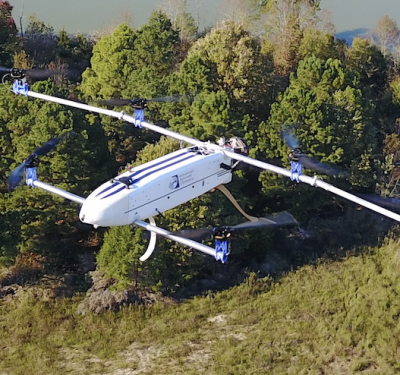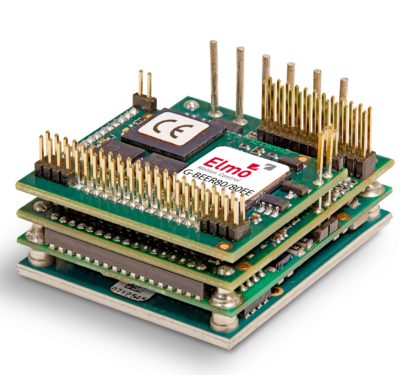
Jim Williams (left), manager of the Federal Aviation Administration’s Unmanned Aircraft Systems Integration Office, shakes hands with Bob Brown, president of the Academy of Model Aeronautics Photo courtesy of FAA
Jim Williams
As manager of the FAA’s Unmanned Aircraft Systems (UAS) Integration Office, Williams leads the agency’s efforts to integrate UAS into the national airspace system (NAS). His office works collaboratively to craft new rules and standards and sponsors UAS-related research and development. The Integration Office coordinates all UAS operational authorizations including requests for Certificate of Waiver or Authorizations (COAs) and Section 333 exemptions.
Williams responded to written questions from Inside Unmanned Systems on key issues impacting the integration of unmanned aircraft.
Question: The rules for integrating unmanned aircraft systems (UAS) into the national airspace are to be developed and released in stages. In February the proposed first set of rules covering small UAS was released for comment. What do you anticipate will be the next step or set of rules for integrating UAS?
Answer: The next steps for rulemaking are being developed by the organizations responsible for the regulations that need to be modified to enable routine flights of Unmanned Aircraft in the U.S. The FAA is considering the next steps to incrementally increase the type and scope of UAS operations in the U.S. Airspace.
Question: How does that next set of provisions fit into your planning? For example, must the small UAS rule be finalized first or can new rules be crafted in parallel? Do you have a rough idea of when the next step might be identified to the public?
Answer: Integration of UAS is an incremental process and the small UAS rule is a key step toward integration, but it doesn’t end there. In conjunction with industry and government partners, as well as the six UAS test sites, we are conducting further research and development to help further integrate UAS into the national airspace system. In addition to this research and development activity, we are also working with various organizations on a number of activities, including the development of operational concepts for further integration.
Question: Many of the exemptions issued under the provisions of Section 333 of the FAA Modernization and Reform Act of 2012 incorporate limits on flight time or a mandate to land with as much as 30 percent of the battery’s power remaining. These parameters directly impact the ability of firms to operate efficiently and economically. How were these limits determined and how do you see them evolving over time?
Answer: In the first exemptions granted by the FAA under Section 333, the petitioner stated that an equivalent level of safety could be achieved by limiting flight duration to 30 minutes or 25% of battery power, whichever occurred first. Therefore, when the FAA granted the exemption request, the conditions and limitations section contained the limitations as put forth by the petitioner. Most exemptions are now granted with conditions and limitations prohibiting the pilot-in-command from commencing a UAS flight unless (considering wind and forecast weather conditions) there is enough available power for UAS to operate for the intended operational time and to operate after that for at least five minutes or with the reserve power recommended by the manufacturer, if greater.
Question: Though the FAA eliminated the need for a Certificate of Authorization or Waiver (COA) for those holding Section 333 exemptions and flying below 200 feet, there are more exemption applications that do not fall into that category. As both the FAA and the UAS industry gain experience is there a possibility of developing a still more flexible process for granting exemptions and COAs? What elements need to be in place for that to happen?
Answer: All Section 333 exemption holders still require a Certificate of Waiver or Authorization (COA) to operate. The COA provides a waiver or authorization for an equivalent level of safety to meet the “see and avoid” requirements. To expedite the process the FAA issued a “blanket” COA for operations in Class G airspace certain distances from airports operating below 200 feet. The blanket COA is attached to the grant of exemption and operators must have both the exemption and COA with them while operating the vehicle.
Question: How will the FAA monitor the operations and compliance of those operators with Section 333 exemptions?
Answer: The FAA will monitor our 333 approved operators the same way we monitor all pilots and commercial operators. One of the key functions for the Flight Standards Service is maintaining continued operational safety for the entire system. We conduct surveillance on a risk-based approach that takes into consideration things like past performance of the operator and risk to the public for the type of operation.
Question: Congress added $4 million to the budget for the new UAS Center for Excellence for a total allocation of $5 million. Lawmakers also added a separate $2 million to further UAS research goals. How is your office deploying those funds? Did the cash infusion impact your planning for the Center?
Answer: The additional $2M appropriated in FY 2015 will be used to accelerate UAS R&D in three key areas, which are prioritized as:
1 Flight testing of command and control radios to validate draft RTCA standards under the limitations imposed by small UAS. This validation will mature the draft standards and help ensure they can be used with a large population of UAS;
2 Evaluation of ground architecture (radios, antennas, networking) necessary to provide reliable command and control links for UAS operating cross country where the UAS will need to switch between multiple ground radios. This ground architecture evaluation will help determine technical limitations of potential architectures to inform ground radio infrastructure decisions of the FAA or a third-party service provider;
3 Evaluation of unique human factors and challenges for UAS and regulatory and policy changes that may be needed to address them. These unique challenges include how to allocate manned pilot functions to a remote pilot, control station standardization, and unique crewmember training requirements.
Distribution of the additional funds for the COE cannot be determined specifically until the COE is selected and the research program is negotiated.






